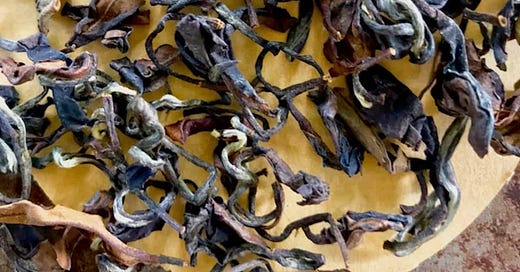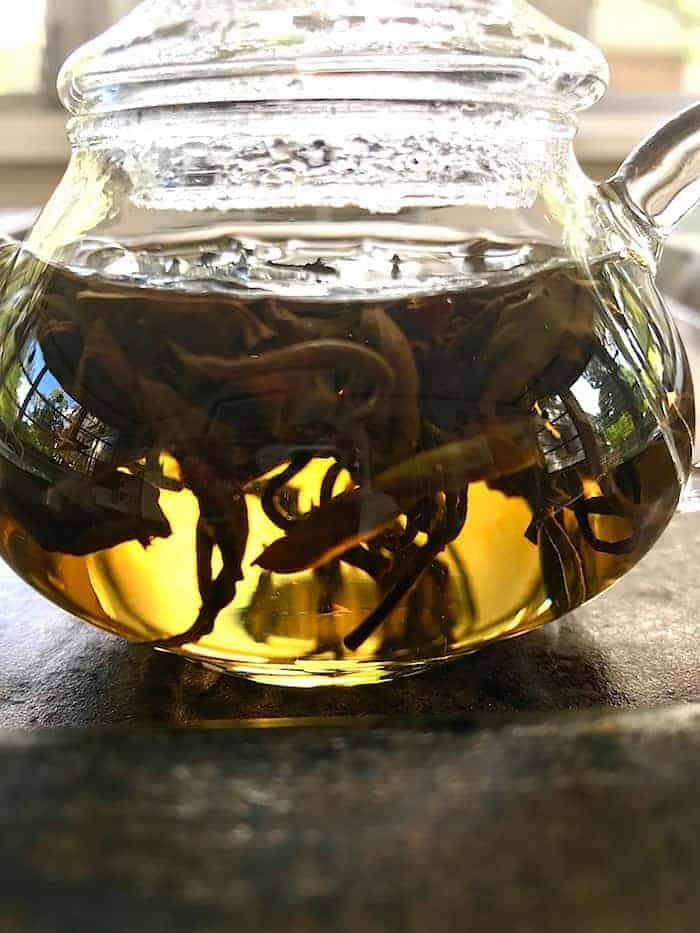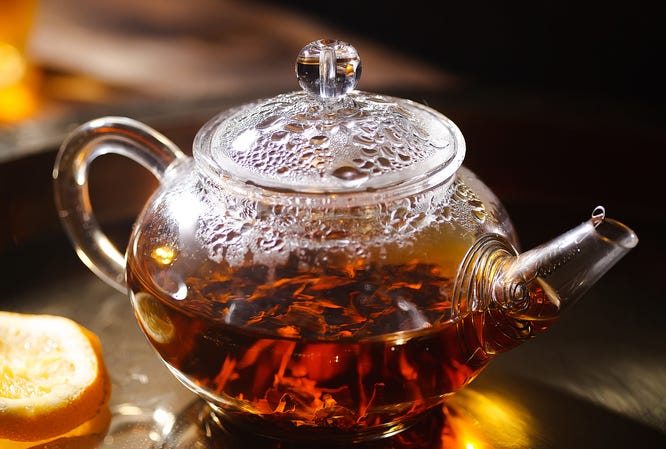The Enchanting Tale of Oriental Beauty: Taiwan's Most Famous Tea
A Unique Oolong Steeped in Legend, Craft, and Natural Sweetness
There’s a legend behind every great tea, and Oriental Beauty is no exception. This rare and extraordinary oolong, with its mesmerizing hues and sweet aroma, almost never existed. It has gone by many names: Formosa Oolong, Champagne Oolong, and White Tip Oolong. In Taiwan, the traditional name is Bai Hao, which means “white-tipped.”
But beyond its many titles lies a story of resilience, nature’s alchemy, and the perfect imperfection that makes this tea one of the most coveted in the world. The first thing you’ll notice about this tea is the striking variety of colors in the dried leaf. This is due to the way the oolong tea is produced. You’ll also notice tiny white hairs from the bud leaf. It’s extraordinary.
Bai Hao is one of my favorite oolongs. I love the aroma of the dried leaf. Its naturally sweet honey and woody fragrance has a slight cocoa scent.
A Tea Born from Nature’s Touch
The history of this tea is remarkable in that it came about quite by accident. According to the story, in the early 19th century, tea farmers in Beipu, Taiwan, thought their crop was ruined until one farmer had a plan.
In the warm summer of Taiwan’s rolling tea fields, the tea bushes stretch toward the sun, their leaves soaking in the heat. But in one particular year, an uninvited guest arrived—leafhoppers. Tiny insects, no larger than a grain of rice, feasted on the young leaves, piercing their delicate surfaces. Most of the farmers, horrified by the damage, abandoned their crops. But one farmer sees something others do not. He harvests the wounded leaves anyway.
As the tea oxidizes, something magical happens. In response to the insects' bites, the plant releases aromatic compounds called terpenes—a self-defense mechanism that ironically enhances the tea’s character. When the farmer finally presented his tea at the market, one tea merchant was stunned. The flavor was unlike anything he had ever tasted—sweet, honeyed, and impossibly smooth. He paid the farmer twice the regular price.
Word spread, and what was once considered ruined tea became a treasure. The locals call it Peng Feng Cha, or Bragger’s Tea, a fitting name for a rare and precious tea that those who owned it couldn’t help but boast about. Eventually, it earned the name we know today: Oriental Beauty.
Quality Oriental Beauty
As you inspect the dry leaf, notice how it is twisted and slightly balled. The multicolored leaves have shades of brown, yellow, red, and green with silvery streaks. Only 40 to 50 percent of the crop is harvested in June or July, so small quantities are available yearly.
Once harvested, the tea is 60 to 65 percent oxidized, giving it a darker color. It is then fired to help retain the flavor. The result is a sweet, fresh, honeyed fruit flavor with the aroma of peaches.
The tea liquor is a buttery amber color. Many oolongs have a woodiness to their taste that I enjoy. This is probably related to how long the leaf is oxidized. The darker leaves seem to produce that woody note without the bitterness or astringency of black teas.
Oolong tea is not quite a green or black tea but is processed somewhere in between. That’s why I call oolong tea the “sweet spot” of tea.
Taiwan teas are famous for their light, refreshing, and fragrant oolongs, which distinctly differ from those produced in Mainland China. These oolongs are often called Formosa oolongs, as the island of Taiwan was once named Formosa, meaning "beautiful island."
READ:
How to Brew Tea Perfectly Every Time
This guide is for transitioning from tea bags to making tea with loose-leaf tea. I’m still learning to make different teas, and I’ve been brewing tea my entire life. I’m not saying exactly how many years that is, but it’s safe to say it’s many!
The Art of Crafting Oolong Tea
Oolong teas are some of the most complex to craft, requiring a meticulous, multi-step process. Each leaf is carefully rolled, a testament to the skill and dedication behind its creation.
The leaves are plucked at their peak and then withered in trays, allowing moisture to evaporate and the natural enzymes to activate.
The leaves are then “rocked” in their trays, causing the leaf cell to rupture and disperse its sweet sap within the leaf.
This action initiates the oxidation process, which is the most critical step. The success of this process depends on the veteran tea maker's synchronous adjustments and traditional experiences. This is where the art of the craft matters.
The leaves are then bruised and tumbled in a variety of ways. Here, the red-tipped edges of the bruised leaf appear.
After resting, the leaves undergo a series of oven firings and tumblings, locking in their flavors and aromas.
Oriental Beauty is A Treasure Worth Seeking
Taiwan exports only a fraction of its annual tea production, and Bai Hao is among its rarest offerings. However, in recent years, the demand for high-quality mountain-grown oolong teas unique to Taiwan has increased.
Consider yourself lucky if you can find a high-end specialty tea shop near you. Consumer tea habits are different in the U.S. and slightly less mature than in other parts of the world, where tea drinking has a deep history.
There are a couple of online retailers that sell quality Bai Hao Oolongs. I'm sure there are many more, but these are the ones I have purchased. If you know of any other shops, please share in the comments.
Adagio Tea sells Oriental Beauty or Bai Hao at several different price points. I have always found their Masters Collection to have superior-quality teas. I've tried their Formosa Bai Hao but prefer their Hsinchu Oriental Beauty.
Tea Vivre carries high-quality Taiwan Oriental Beauty under its Oolong collection, sourced from Taiwan’s famed tea regions.
More Than a Tea—A Daily Ritual
Beyond its rarity and exquisite taste, oolong tea is a gift to both body and mind. While specific studies on Oriental Beauty are limited, research on oolong teas generally suggests remarkable health benefits.1
Rich in antioxidants – Oolong teas are rich in polyphenols, which exhibit strong antioxidant activities. Reducing oxidative stress supports cellular health.
Supports weight management – Enhances metabolism and fat oxidation.
Heart-healthy – This may help regulate cholesterol and blood pressure.
Balances blood sugar – Aids in glucose metabolism, beneficial for those with type 2 diabetes.
Boosts cognitive function – Caffeine and L-theanine work together to enhance focus and memory.2
Yet, beyond the science, tea is about presence — a moment of connection, gratitude, and beauty. Incorporating oolong tea into your daily routine may offer some health benefits. Still, I hope you can experience this fantastic tea not only for its possible health benefits, but also for its delightful taste.
References
Luo, Q., Luo, L., Zhao, J., Wang, Y., & Luo, H. (2024). Biological potential and mechanisms of Tea's bioactive compounds: An Updated review. Journal of advanced research, 65, 345–363. https://doi.org/10.1016/j.jare.2023.12.004
Einöther, S. J., & Martens, V. E. (2013). Acute effects of tea consumption on attention and mood. The American journal of clinical nutrition, 98(6 Suppl), 1700S–1708S. https://doi.org/10.3945/ajcn.113.058248







Beautiful. I love the story and am so excited to get to know oolong better. ❤️